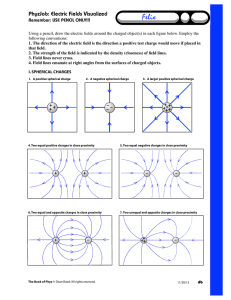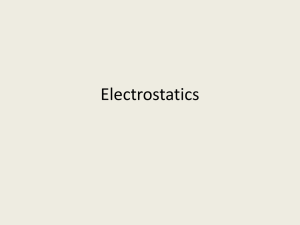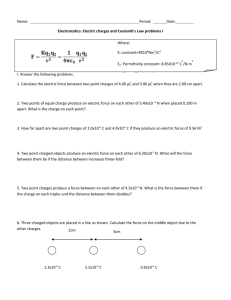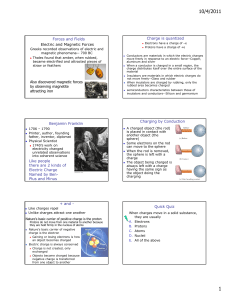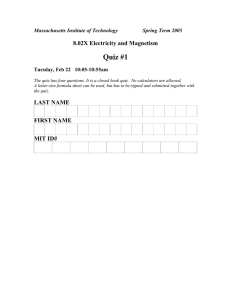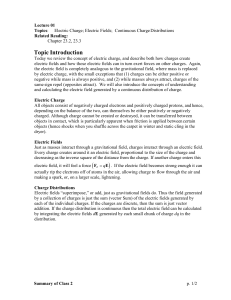Electric Fields and Force
advertisement
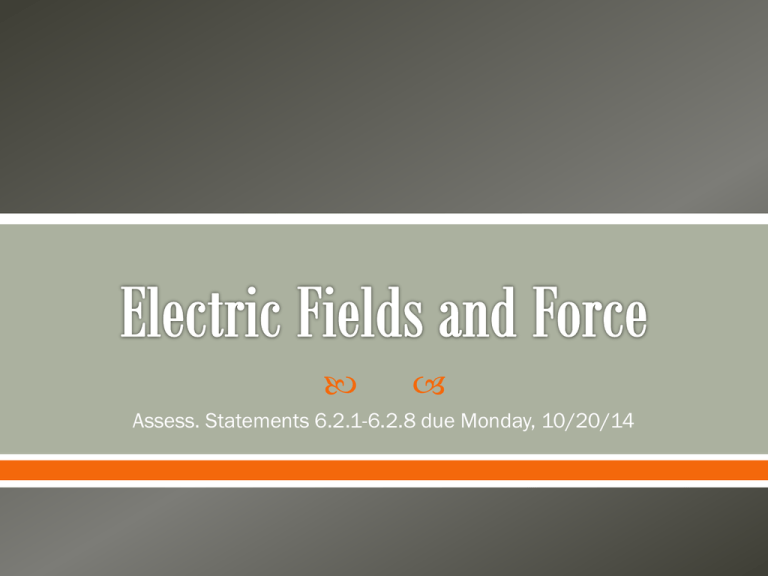
Assess. Statements 6.2.1-6.2.8 due Monday, 10/20/14 Like the gravitational field around masses, an electric field occupies the space surrounding charged objects. To test for the presence of an electric field: o Bring a small positive charge (q) into the space o Release the small positive charge • If the charge experiences a force, then we know there is an electric field present • No force, no electrical field Known as a Test Charge Attractive forces The test charge will accelerate towards the negatively charged object The test charge will follow the path of the electric field of the negative object: Electric charges exert forces on other electric charges through the electric fields Quantified through Coulomb’s Law: o The electric force between two point charges, Q 1 and Q2, is inversely proportional to the square of their separation distance and directly proportional to the product of the two charges: 𝑘𝑄1 𝑄2 𝐹= 𝑟2 𝑘= 1 4𝜋𝜀0 = 8.99 × 10−9 N·m2·C-2 e0electric permittivity of a vacuum o (= 8.85 x 10-12 C2·N-1·m-2) Two charges, 4.00 mC and 6.00 mC, are placed along a straight line separated by a distance of 2.00 cm. Find the force exerted on each charge. 𝑞1 = 4.00 × 10−6 𝐶 𝑞2 = 6.00 × 10−6 𝐶 𝑟 = 0.0200 𝑚 𝑘𝑄1 𝑄2 𝐹= 𝑟2 (8.99 × 10−9 )(4.00 × 10−6 )(6.00 × 10−6 ) 𝐹= 0.02002 𝐹 = 540 𝑁, 𝑟𝑒𝑝𝑢𝑙𝑠𝑖𝑣𝑒 𝑓𝑜𝑟𝑐𝑒 Two equally charged lightweight balls, q, are suspended from strings that are each 10.0 cm long. They repel each other and have a separation distance between the charged particles is 14.00 cm. Assume the mass of each of the lightweight balls is 0.575 g. What is the charge on each of the balls? Electric field lines are drawn in the same direction as the force the small postive test charge would experience at that point. 𝐹 𝐸= 𝑞 The electric field strength is defined as the force per unit charge experienced by a small positive test charge, q. The electric field strength is FELT by the charge in the field itself. The electric field strength is CAUSED by the charge creating the field Electric field strength depends on the charge that is creating the field, and it depends on how far away from the charge the field is being measured: 𝑘𝑄1 𝑄2 𝐹= 𝑟2 𝐹 𝐸= 𝑞 𝐴𝑠𝑠𝑢𝑚𝑒 𝑄2 𝑖𝑠 𝑡ℎ𝑒 𝑠𝑎𝑚𝑒 𝑎𝑠 𝑞 𝑘𝑄𝑞 𝐹 𝑘𝑄 2 𝑟 𝐸= = = 2 𝑞 𝑞 𝑟 What is the electric field strength 7.50 cm from a particle with a charge of 5.00 mC? What force would a charge of +1.00 nC experience at that point? The electric field between two parallel plates is 100.0 N·C-1. What acceleration would a charge of 2.00 mC and mass 1.00 x 10-3 kg experience if placed in this field? (ignore the weight of the charged mass) Imagine an electric field generated by a charge Q, and consider a positive test charge, q, in that field. What must be done to move q closer to Q? Electric Potential is the work done per unit charge to bring a positive test charge from far away to the some point P in an electric field created by Q 𝑊 𝑉= 𝑞 The work done in moving the charge to point P from infinity increases the electrical potential energy of the test charge. The work done in moving a test charge of 2.0 mC from very far away to a point P is 1.50 x 10-8 J. What is the electric potential at point P? The potential at a point P is 12.0 V and a charge of 3.00 C is placed there. What is the electric potential energy of the charge? What is the electric potential energy if the charge placed at P is – 2.00 C? Electric potential difference: the work done to move a charge from point A in an electric field to point B in an electric field (neither is very far away from the source of the field). Mathematically, it’s the difference of potential energy for the charge at each of the positions (W = DU) Potential difference is the total work done to move the charge (change in energy) Potential is the work per unit charge. What work must be performed in order to move a charge of 5.00 mC from the negative plate to the positive plate if a potential difference of 250. V is established between the plates? A charge of 5.00 mC and mass 2.00 x 10-8 kg is shot with an initial velocity of 3.00 x 102 m·s-1 between two parallel plates kept at a potential of 200.0 V and 300.0 V, respectively. (the charge starts at the low potential end) o What will the speed of the charged mass be when it gets to the other (higher potential) plate? The amount of work needed to move a charge equal to one electron’s charge through a potential difference of exactly 1 volt. What is the work needed to move a charge of +2e across a potential difference of 2.0 V? What is the work needed to move a charge of +3e across a potential difference of 5.0 V? What is the equivalent of 1 eV, measured in Joules? 1 eV = work to move 1e through 1V What’s the charge of 1e? W = qV=(1.61x10-19 C)·(1 V) = 1.61 x 10-19 J



